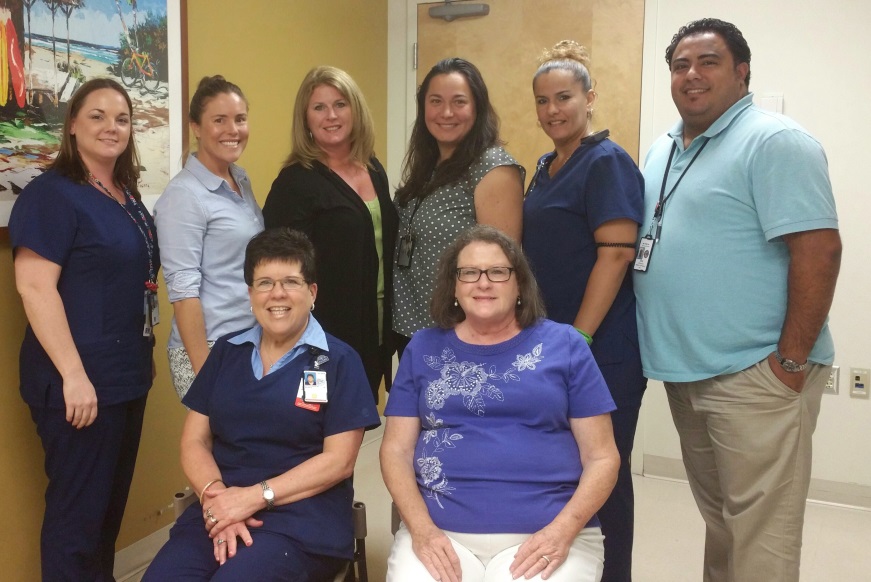Too often, patients are readmitted to hospitals for the same health issues within 30 days of discharge. These re-hospitalizations are costly, potentially harmful, waste resources and often avoidable.
The team at the VA Pittsburgh Healthcare System understood that to reduce re-admissions and improve the overall inpatient experience for Veterans, they needed to improve care transitions and build a more collaborative and inter-professional team. So, the Pittsburgh Veteran Engineering Resource Center (VERC) led an initiative in collaboration with the national Patient Care Services program office to develop the Reducing Re-admissions through Improving Care Transitions (RRTICT) approach as a pilot project at Pittsburgh with the aim to reduce 30-day re-admissions.
RRTICT builds upon best practices identified at VA and non-VA medical centers and combined with a near real-time predictive model to deliver tailored care to the Veteran. This means that the care management team conducts a risk assessment for each individual Veteran that guides customized strategies for in-hospital and post-discharge care coordination based on the identified risk level targeted to meet the needs of each individual patient.
After the Pittsburgh pilot, RRTICT was expanded to seven additional VA medical centers located in Albany, Bay Pines, Gainesville, Miami, Omaha, San Juan, and Sioux Falls. Already these facilities – and most importantly, Veterans — are experiencing the benefits of RRCIT.
The C.W. Bill Young VA Medical Center in Bay Pines, Florida, provides a great example of how RRTICT reduced re-admissions and improved the experiences of their Veterans:
As described by Laura Ackerman, RN, Patient Centered Care Coordinator:
Problem: Our team noted that a patient who was admitted for uncontrolled diabetes mellitus was admitted to the hospital for the fourth time in the past 12 months for the same reason. A patient care coordinator met with the patient one-on-one at bedside to inquire about his multiple admissions.
The care coordinator learned that the patient felt he didn’t have the education and/or resources he needed to properly manage his diabetes at home. The patient had previously been advised to attend diabetes education classes but when asked why he was a no-show, he stated that he does not do well in a classroom setting and had a difficult time getting to classes at VA.
Solution: The inpatient care team met to discuss the patient’s needs and we were able to enroll patient in the Post Hospital Transition clinic to help him with his diabetes care post discharge. We followed up 30 days after discharge to reiterate diabetes education given while in the hospital. The patient was also enrolled in the home telehealth program and was able to better transition to this program with the help of the clinic to help him manage his diabetes from home. He was also identified as home bound and was transferred to the VA’s home based primary care program to help him receive his medical care from home since it was difficult for him to get to the VA for his appointments and care.
Results: Because we were able to identify this patient’s high risk for readmission, the patient care team was able to identify the patient’s needs to help manage his care from home. As a result of RRTICT, the patient has not had any re-admissions since this hospitalization.
During the length of this pilot Bay Pines saw the readmission rate decrease 27 percent from 15.9 percent to 11.7 percent. Using the average cost of a single readmission at Bay Pines of $11,704 in 2014, a drop of re-admissions by 27 percent in 2015 equals to cost avoidance of $866,096 for the six months this pilot was conducted.
This Bay Pines story is just one example of how utilizing RRTICT early on in the admission benefits the whole patient care team, family members and ultimately the Veteran.
Over the six month period in FY 2015 that RRTICT was piloted on medicine wards at seven VA medical centers, there was an average 28 percent reduction in 30 day all-cause re-admissions when compared to FY 2014. Participating medical center staff indicated an increase in positive workplace culture and improved communication between care team members.
The RRTICT pilot allowed care teams to recognize:
- The benefits of a multidisciplinary patient care team in the care coordination of each and every patient;
- The high effectiveness of a risk predictor tool in planning care;
- The impact of engaging and educating staff on resources available to Veterans; and
- How having an effective discharge process is important in successful discharge planning to prevent re-admissions in the hospital.
RRTICT offers the VA an opportunity to improve Veteran outcomes and, potentially, Veteran perception of VA care. RRTICT supports MyVA breakthrough priorities and the VA Under Secretary of Health’s top five priorities for best practices while improving the Veteran experience and employee engagement.
We are extremely proud of our “FY16 Trending Practice” and the impact of our work to reduce re-admissions. We look forward to supporting other facilities as they replicate and adapt the RRTICT approach across the nation.

Topics in this story
More Stories
Black Lab Raisin reminds Veterans of life outside the hospital, brightens their lives with her endless capacity for joy.
VA remains open for business and is closely monitoring the Change Healthcare (CHC) cybersecurity incident.
Take the stress out of travel. My HealtheVet makes preparing for your time away easy with these five quick tips.







I am a service connected disabled veteran. When I die do all the benefits for dependents die with me or will they continue to receive my benefits. One of my dependents is a helpless child.
I’m sorry to say when u have np and student doctor c I Bing up for doctors they never tell vet the truth make the veterans suffered, they keep changing primary care doctor keep the veterans fight for health care,. So it big brother the puppeteer doctor below puppets includes np, nurses, it needs start top last 2yrs it has hit bottom of the ocean for heath care. I was told doc student it old age 2nd opinion found thing she never told me , cover up these doctors never chk cc what new for migraine I told doc never chk it out I did, it from a va blob from another va cost 375 vet stop all meds for headaches, keep giving med that gives nasty side effects , or no pills on side effects Apr 7 type in migraine